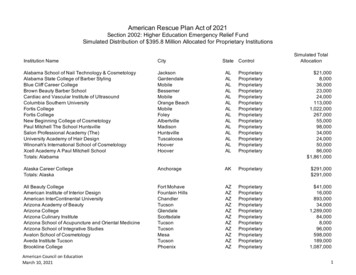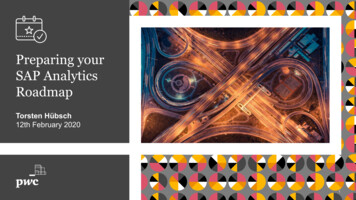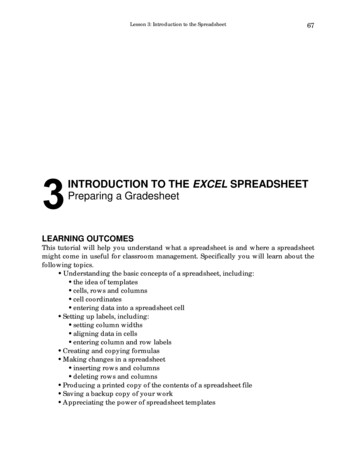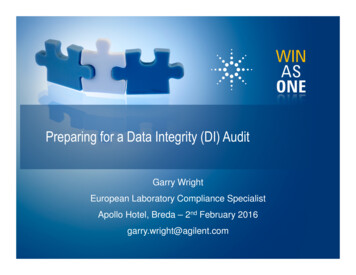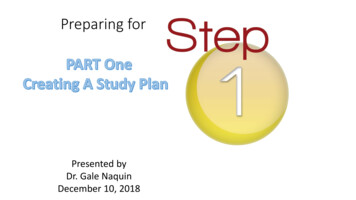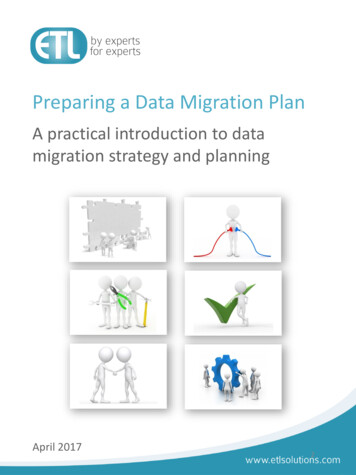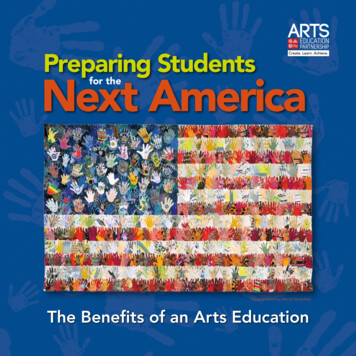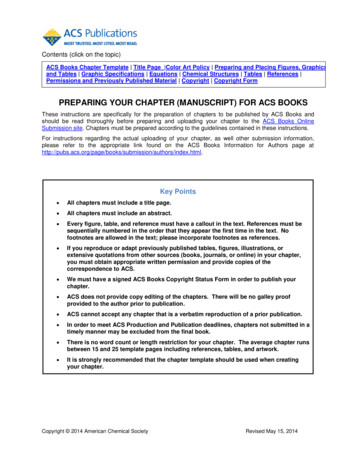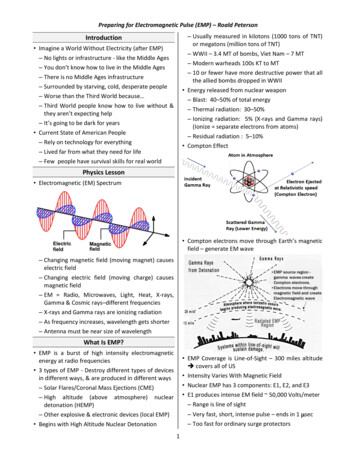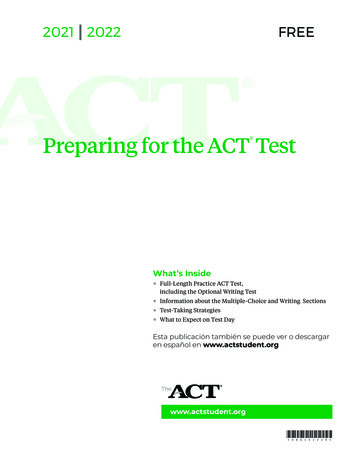
Transcription
2021 l 2022 FREEPreparing for the ACT Test What’s Inside Full-Length Practice ACT Test,including the Optional Writing TestInformation about the Multiple-Choice and Writing SectionsTest-Taking StrategiesWhat to Expect on Test DayEsta publicación también se puede ver o descargaren español en www.actstudent.orgwww.actstudent.org*080192220*
A Message to StudentsThis booklet is an important first step as you get ready for college and your career.The information here is intended to help you do your best on the ACT to gain admission to colleges anduniversities. Included are helpful hints and test-taking strategies, as well as a complete practice ACT, with“retired” questions from earlier tests given on previous test dates at ACT test sites. Also featured are apractice writing test, a sample answer document, answer keys, and self-scoring instructions.Read this booklet carefully and take the practice tests well before test day. That way, you will be familiarwith the tests, what they measure, and strategies you can use to do your best on test day.You may also want to consider The Official ACT Self-Paced Course, Powered by Kaplan to learntest content and strategies in a virtual classroom. To view all of our test preparation options, go towww.act.org/the-act/testprep.Overview ofthe ACTContentsA Message to Students bOverview of the ACT bTest-Taking Strategies 1The full ACT consists of four multiple-choice sections—inEnglish, mathematics, reading, and science—with an optionalwriting section. Some colleges and universities require oraccept ACT writing scores, so you may consider taking thewriting section.Prohibited Behavior atthe Test Center 3TestContent of the ACT Sections 4Taking the Practice Tests 8Minutes per TestEnglish7545Mathematics6060Reading403540351 essay40SciencePractice Multiple-Writing (optional)Choice Sections 9ACT tries out questions on National test dates to develop futuretests. Your test may include questions that will not counttowards your score. Please try your best on these questions.Your participation can help shape ACT’s future.Practice Writing Test 50Practice Answer Document 53Scoring Your Tests 55 2021 by ACT, Inc. All rights reserved. JA00003.CJ7027Questionsb
Test-Taking StrategiesTest Strategies for the ACTmay want to work out the answer you feel is correct and lookfor it among the choices given. If your answer is not amongthe choices provided, reread the question and consider allthe answer choices.Each multiple-choice section contains questions with eitherfour or five answers from which you are to choose the correct, orbest, answer.9 Read each question carefully.The ACT measures the knowledge, understanding, and skillsyou have acquired throughout your years in school. Because ofthis, it is unlikely that a “cram” course can improve your scores.However, it is a good idea to do some test preparation to befamiliar with the tests and what to expect on test day.You need to understand exactly what each question asks. Somequestions will require you to go through several steps to findthe correct or best answer, while others can be answered morequickly.9 Answer the easy questions first.Here are three strategies to help you prepare for the ACT:A good strategy is to answer the easy questions and skip thequestions you find difficult. After answering the easy questions,go back and answer the more difficult questions if you havetime.9 Get familiar with the content of the sections.Review the information in this booklet. Note which contentareas make up a large proportion of the sections. The topicsincluded in each content area are examples of possible topics;9 Use logic on more difficult questions.they do not include all possibilities.When you return to the more difficult questions, try to use logicto eliminate incorrect answers. Compare the answer choicesto each other and note how they differ. Such differences mayprovide clues as to what the question requires. Eliminate asmany incorrect answers as you can, then make an educatedguess from the remaining answers.9 Update your knowledge and skills in the contentareas.Review content areas that you have studied but are not fresh inyour mind. Refresh your knowledge in the content areas thatmake up large portions of the test.9 Study content areas you are not familiar with.9 Answer every question.If some content areas of the ACT are unfamiliar to you, considertaking coursework in those areas before you take the test.Your scores in the sections will be based only on the numberof questions that you answer correctly; there is no penalty forguessing. Try to answer every question within the time allowedfor each section.Tips for Taking the Multiple-ChoiceSections9 Review your work.9 Pace yourself.If there is time left after you have answered every question in asection, go back and check your work. You will not be allowed togo back to any other section or mark responses to a section aftertime has been called in that section.It is important that you have enough time to read the passages/questions and figure out your responses. For each section,subtract the number of minutes you estimate you will spendskimming the passages or reading the information provided,then divide the total number of remaining minutes allowed bythe number of questions to determine the estimated time youshould spend on each question. If possible, spend less time oneach question and use the remaining time allowed for a sectionto review your work and return to the questions in that sectionthat were most difficult for you.When testing on an answer document:9 Be precise in choosing your responses.If you are taking the ACT on paper, make sure that you properlyselect the desired answer on your answer document. Marks onyour answer document that extend beyond the intended ovalmay be scored as incorrect.The time limits set for each section give nearly everyoneenough time to finish all questions. However, you will want topace yourself to avoid spending too much time on one passageor puzzling over an answer to a specific problem. Go on to otherquestions and come back if there is time.9 Erase completely.If you want to change a multiple-choice answer on paper,make sure you erase completely. Do not cross out answersor use correction fluid or tape; you must erase. Smudges orunintended marks may cause errors in scoring.9 Read the directions carefully.Before you begin each section, read the directions carefully. The English, reading, and science sections ask for the bestanswer. Read and consider all of the answer choices andchoose the answer that best responds to the question.The mathematics section asks for the correct answer. You1
Get ReadyWhat NOT to Bring Prepare well in advance for the ACT. Know what to expect on test day. Review the information inthis booklet and at www.actstudent.org.Take the practice tests in the order they are shown in thisbooklet, time yourself, and review your responses using theanswer keys.Carefully review the test-day checklist atwww.act.org/the-act/checklist. On Test Day Report on TimeFor National test dates, you must report to your assignedtest site by the time stated on your admission ticket (usually8:00 a.m.). If you are late, you will not be admitted to test. Ifyour ticket does not list a specific test room, the test staff orposted signs will direct you. What to Bring Highlighter pens, colored pens or pencils, or correctionfluid/tape.Any electronic device, other than a permitted calculator.Reading material.Tobacco in any form.In the Test RoomGet plenty of rest the night before the tests.Note: Most procedures in this booklet refer to testing on aNational test date at an ACT test center (within the United States,US territories, or Puerto Rico). Procedures may differ slightly ifyou take a different administration of the ACT test. Textbooks, foreign language or other dictionaries, scratchpaper, notes, or other aids.A printed copy of your admission ticket. Your ticket containsimportant information that helps connect your answerdocument to the registration on file. If you have lost yourticket, you can print another through your MyACT account.If you do not bring your ticket on test day, your scores maybe delayed.Test staff will direct you to a seat. If you need a left-handeddesk, tell the staff as you enter.Do not leave the test room after you have been admitted.Only pencils, erasers, a permitted calculator, your watch(if brought to the test center), and your paper ticket will beallowed on your desk.You will be required to put all other personal belongingsaway.You may not use tobacco in any form. You may consumesnacks and drinks outside the test room during the break.Reporting time for the test will be 8:00 a.m. Testing willbegin as soon as all examinees who are present at 8:00 a.m.are checked in and seated.Listen carefully to all directions read by the test staff.It is important that you follow all directions carefully.For the full ACT, you will normally be dismissed at about12:35 p.m. if you take the ACT (no writing), or at about 1:35p.m. if you take the ACT with writing.For Students Approved to Test atNational Test Sites With One andOne-Half TimeAcceptable photo identification. You will not be permittedto test if your ID does not meet ACT requirements.See ACT requirements for ID on your ticket or atwww.act.org/the-act/id.Testing with one and one-half time is available on the multiplechoice and/or writing sections for students with diagnoseddisabilities and/or limited English proficiency.Number 2 Pencil. Bring sharpened No. 2 pencils and gooderasers (no mechanical pencils or ink pens). Do not bringany other writing instruments. You will not be allowed to usethem.Note: International test sites are provided approvedwhiteboards and erasable markers.If you are approved for one and one-half time at a Nationaltest site, you will have 50% additional time to complete eachsection.The full ACT:TestWatch. You may bring a watch to pace yourself, but do notbring a watch with an alarm. During testing, your watchmust be removed and placed on your desk face up. If youralarm sounds during testing, you’ll be dismissed and youranswers will not be scored.QuestionsMinutes per TestEnglish7570Mathematics6090Reading405540551 essay60ScienceCalculator. Bring a permitted calculator to be used onthe mathematics test only. You are not required to usea calculator at all, but if you do, it is your responsibilityto know whether your calculator is permitted. Fora current copy of the calculator policy, please visitwww.act.org/calculator-policy.html.Writing (optional)Snacks to eat outside the test room during breaks.2
After TestingTesting More Than Once In theSame AdministrationVoiding Your Test on Test DayYou may not receive scores from more than one test takenduring a scheduled National or International test date. Forexample, you may test on Saturday, on an authorized nonSaturday date, or on a rescheduled test date—but not on morethan one of those days on a particular test date. If you areadmitted and allowed to test a second time on a particulartest date, we will report only the scores from the first test. Thesecond set of scores will be canceled without refund.If you have to leave the test site before completing all of yourtests, you must decide whether or not you want your test scoredand then inform the test staff of your decision. If you do not,your test will be scored.Once you access test content, you cannot request a Test DateChange. If you do not complete all your sections and want totest again, you will have to pay the full fee for your test optionagain. Once you begin filling out your test, you cannot changefrom one test option to another.Requesting a Copy of YourTest Questions and AnswersTesting More Than OnceOn certain test dates, you may order (for an additional fee) acopy of the multiple-choice test questions used to determineyour scores, a list of your answers, and the answer key. If youtook the writing section, you will also receive a copy of thewriting prompt, scoring guidelines, and the scores assigned toyour essay.If you wish to take the test again to increase your scores,ACT will calculate and report a superscore for students whohave taken the ACT test more than once. This gives collegesthe option to use the student’s best scores from all testadministrations, rather than scores from just one sitting, intheir admission and scholarship decisions.For information about superscoring, seewww.act.org/the-act/superscore.This service is not available for all test dates and is availableonly for National testing or Special testing in the United States,US Territories, and Puerto Rico. Restrictions apply.For more information about retaking the ACT, seewww.act.org/the-act/retaking.If you are interested in this service, checkwww.act.org/the-act/tir for more detail.Prohibited Behavior at the Test Center A complete list of the prohibited behaviors was provided duringthe registration process. The following behaviors can also resultin dismissal. Please be reminded of the following: For paper testing, you may not fill in or alter responses toany multiple-choice questions or continue to write or alterthe essay after time has been called. This includes fixingstray marks. For paper testing, you may not look at any section of the testoutside of the designated time for that test.You may not access an electronic device (other than yourtesting computer and mouse, when testing online) at anytime during testing or during breaks. All other devices mustbe powered off and placed out of sight from the time you areadmitted to the test room until you are dismissed. You may not give or receive assistance by any means. Thisincludes looking at another person’s test.The test is confidential and remains so even after the examis complete. You may not remove any materials from thetest room. You may not discuss or share test questions,answers, or test form identification numbers during testadministration, during breaks, or after the test.You may not disclose test questions or answers in any way orat any time, including through social media, in whole or inpart.Eating, drinking, and the use of tobacco or reading materialsare not permitted in the test room.If you are observed or suspected of engaging in prohibitedbehavior, you will be dismissed and your test will not be scored.3
Content of the ACT SectionsEnglish SectionTips for Taking the English Section9 Be aware of the writing style used in each passage.The English section consists of multiple essays, or passages,each followed by a set of multiple-choice questions. The passages cover a variety of topics and are written in a varietyof styles. It is important that you take into account the writingstyle used in each passage. When responding to a question, besure to understand the context of the question. Consider howthe sentence containing an underlined or highlighted portionfits in with the surrounding sentences and into the passage as awhole.For paper testing, some questions refer to underlinedportions of the passage and offer several alternatives to theunderlined portion. For online testing, these questions willrefer to highlighted portions of the passage. You decidewhich choice is most appropriate in the context of thepassage.9 Examine the underlined or highlighted portionsSome questions ask about an underlined or highlightedportion, a section of the passage, or the passage as a whole.You decide which choice best answers the question posed.of the passage.Before responding to a question with an underlined orhighlighted portion, carefully examine what is underlinedor highlighted in the text. Consider the elements of writingMany questions offer “NO CHANGE” to the passage as one ofthe choices.The English section puts you in the position of a writer whomakes decisions to revise and edit a text. Essays in differentgenres provide a variety of rhetorical situations.included in each underlined or highlighted portion. These passages are chosen for their appropriateness inassessing writing and language skills and to reflect students’interests and experiences. Four scores are reported for the English section: a score for thesection overall and three reporting category scores based onspecific knowledge and skills. The approximate percentage ofthe section devoted to each reporting category is:9 Be aware of questions with no underlined portions.You will be asked some questions about a section of the passageor about the passage as a whole, in light of a given rhetoricalsituation. Questions of this type are often identified by aquestion number in a box located at the appropriate point in thepassage or by a highlighted asterisk in brackets.This category requires you to apply your understanding of thepurpose and focus of a piece of writing. Topic Development: Demonstrate an understanding of,and control over, the rhetorical aspects of texts. Identify thepurposes of parts of texts, determine whether a text or part ofa text has met its intended goal, and evaluate the relevanceof material in terms of a text’s focus.Questions about the entire passage are placed at the end of thepassage. For paper testing, these questions are introduced by ahorizontal box enclosing the following instruction: “Questionsand ask about the preceding passage as a whole.” For onlinetesting, similar instructions will appear above the individualquestions.Organization, Unity, and Cohesion: Use various strategiesto ensure that a text is logically organized, flows smoothly,and has an effective introduction and conclusion.9 Note the differences in the answer choices.Knowledge of Language (13–19%)Many of the questions in the section will involve more thanone aspect of writing. Examine each answer choice and how itdiffers from the others. Be careful not to choose an answer thatcorrects one error but causes a different error.These questions require you to demonstrate effective languageuse through ensuring precision and concision in word choiceand maintaining consistency in style and tone.Conventions of Standard English (51–56%)9 Determine the best answer.These questions require you to apply an understanding ofthe conventions of standard English grammar, usage, andmechanics to revise and edit text. Some questions will ask you to choose the alternative to theunderlined portion that is NOT or LEAST acceptable.The answer choices for each question will contain changes inone or more of those elements of writing.Production of Writing (29–32%) Some questions will ask you to base your decision on somespecific element of writing, such as the tone or emphasis thetext should convey.When a question asks you to choose the best alternative toan underlined or highlighted portion, consider the followingapproach: Sentence Structure and Formation: Applyunderstanding of sentence structure and formation in a textand make revisions to improve the writing.Decide how the underlined or highlighted portion mightbest be phrased in standard written English or in terms ofthe particular question posed. If the underlined or highlighted portion is the bestanswer, select “NO CHANGE.” If not, check to see whether your phrasing is one of thePunctuation: Recognize common problems with standardEnglish punctuation and make revisions to improve thewriting.Usage: Recognize common problems with standard Englishusage in a text and make revisions to improve the writing.other answer choices. If you do not find your phrasing,choose the best of the answers presented.4
For questions cued by a number in a box or a highlightedasterisk in brackets, decide which choice is most appropriate interms of the question posed or the stated rhetorical situation.9 Reread the sentence, using your selected answer. Once you have selected the answer you feel is best, rereadthe corresponding sentence(s) of the passage, inserting yourselected answer at the appropriate place in the text to make sureit is the best answer within the context of the passage.Mathematics SectionThis category focuses on measuring how well you cansynthesize and apply your understandings and skills tosolve more complex problems. The questions ask you toaddress concepts such as rates and percentages; proportionalrelationships; area, surface area, and volume; average andmedian; and expressing numbers in different ways. Solvenon-routine problems that involve combining skills in chainsof steps; applying skills in varied contexts; understandingconnections; and demonstrating fluency.Most questions are self-contained. Some questions may belongto a set of several questions (e.g., each about the same graph orchart).The material covered emphasizes the major content areasthat are prerequisites to successful performance in entry-levelcourses in college mathematics. Knowledge of basic formulasand computational skills are assumed as background forthe problems, but recall of complex formulas and extensivecomputation are not required.ModelingThis category represents all questions that involve producing,interpreting, understanding, evaluating, and improvingmodels. Each question is also counted in other appropriatereporting categories above. This category is an overall measureof how well you use modeling skills across mathematical topics.Note: You may use a calculator on the mathematics section.See www.act.org/calculator-policy.html for details aboutprohibited models and features.Nine scores are reported for the mathematics section: ascore for the section overall and eight reporting categoryscores based on specific mathematical knowledge and skills.The approximate percentage of the section devoted to eachreporting category is:Tips for Taking the MathematicsSection9 If you use a calculator, use it wisely.All of the mathematics problems can be solved without acalculator. Many of the problems are best done without acalculator. Use good judgment in deciding when, and when not,to use a calculator. For example, for some problems you maywish to do scratch work to clarify your thoughts on the questionbefore you begin using a calculator to do computations.Preparing for Higher Mathematics(57–60%)This category covers the more recent mathematics that studentsare learning, starting when they began using algebra as ageneral way of expressing and solving equations. This categoryis divided into five subcategories: Statistics and Probability (8–12%): Describe center andspread of distributions. Apply and analyze data collectionmethods. Understand and model relationships in bivariatedata. Calculate probabilities by recognizing the relatedsample spaces.Integrating Essential Skills (40–43%)The mathematics section is designed to assess themathematical skills students have typically acquired in coursestaken up to the beginning of grade 12. relationships or surface area and volume measurements.Apply your understanding to composite objects, and solvefor missing values in triangles, circles, and other figures. Usetrigonometric ratios and equations of conic sections.9 Solve the problem.Number and Quantity (7–10%): Demonstrate knowledgeof real and complex number systems. Reason with numericalquantities in many forms, including expressions with integerand rational exponents, and vectors and matrices.To work out solutions to the problems, you will usually do scratchwork. You may wish to glance over the answer choices afterreading the questions. However, working backwards from all fiveanswer choices can take a lot of time and may not be effective.Algebra (12–15%): Solve, graph, and model multipletypes of expressions. Interpret and use many differentkinds of equations, such as linear, polynomial, radical,and exponential relationships. Find solutions to systemsof equations, even when represented by a simple matrixequation, and apply results to real-world contexts.9 Find your solution among the answer choices.Once you have solved the problem, look for your answeramong the choices. If your answer is not included among thechoices, carefully reread the problem to see whether you missedimportant information. Pay careful attention to the questionbeing asked. If an equation is to be selected, check to seewhether the equation you think is best can be transformed intoone of the answer choices provided.Functions (12–15%): Demonstrate knowledge of function:definition, notation, representation, and application. Usefunctions including linear, radical, piecewise, polynomial,exponential, and logarithmic. Manipulate and translatefunctions, as well as interpret and use important features ofgraphs.9 Make sure you answer the question.The solutions to many questions will involve several steps. Makesure your answer accounts for all the necessary steps. Frequently,an answer choice is an intermediate result, not the final answer.Geometry (12–15%): Apply your knowledge of shapes andsolids, using concepts such as congruence and similarity5
9 Make sure your answer is reasonable.Integration of Knowledge and Ideas(13–23%)Sometimes an error in computation will result in an answer thatis not practically possible for the situation described. Alwaysthink about your answer to determine whether it is reasonable.This category requires you to understand authors’ claims,differentiate between facts and opinions, and use evidence tomake connections between different texts that are related bytopic. Some questions will require you to analyze how authorsconstruct arguments, and to evaluate reasoning and evidencefrom various sources.9 Check your answer.You may arrive at an incorrect solution by making commonerrors in the problem-solving process. If there is time remainingbefore the end of the mathematics section, it is important thatyou reread the questions and check your answers to make surethey are correct.Visual and Quantitative Information inthe Reading SectionReading SectionBeginning in 2021, one passage in the Reading section maybe accompanied by a graph, figure, or table that containsinformation relevant to the reading task. In the passagescontaining these visual and quantitative elements, some of thequestions will ask the student to integrate the information fromthe passage and graphic to determine the best answer. Theseitems will contribute to the student’s score in the Integration ofKnowledge and Ideas reporting category.The reading section measures your ability to read closely,reason logically about texts using evidence, and integrateinformation from multiple sources.The section questions focus on the mutually supportive skillsthat readers must bring to bear in studying written materialsacross a range of subject areas. Specifically, questions will askyou to determine main ideas; locate and interpret significantdetails; understand sequences of events; make comparisons;comprehend cause-effect relationships; determine the meaningof context-dependent words, phrases, and statements; drawgeneralizations; analyze the author’s or narrator’s voice andmethod; analyze claims and evidence in arguments; andintegrate information from multiple texts.Tips for Taking the Reading Section9 Read each passage carefully.Before you begin answering a question, read all of the contentcarefully. Be conscious of relationships between or amongideas. You may take note about important ideas in the passages.The reading section is composed of multiple parts. Some partsconsist of one long prose passage and others consist of shorterprose passages. The passages represent the levels and kinds oftext commonly encountered in first-year college curricula.9 Refer to the passages when answering thequestions.Answers to some of the questions will be found by referringto what is explicitly stated in the text of the passages. Otherquestions will require you to determine implicit meaningsand to draw conclusions, comparisons, and generalizations.Consider the text before you answer any question.Each passage is preceded by a heading that identifies theauthor and source, and may include important backgroundinformation to help you understand the passage. Each portioncontains a set of multiple-choice questions. These questionsdo not test the rote recall of facts from outside the passage orrules of formal logic, nor do they contain isolated vocabularyquestions. In sections that contain two shorter passages, someof the questions involve both of those passages.Science SectionThe science section measures the interpretation, analysis,evaluation, reasoning, and problem-solving skills required inthe natural sciences. The section presents several authenticscientific scenarios, each followed by a number of multiplechoice questions.Five scores are reported for the reading section: a score for thesection overall and three reporting category scores based onspecific knowledge and skills; and an Understanding ComplexTexts indicator. The approximate percentage of the sectiondevoted to each reporting category is:The content includes biology, chemistry, Earth/space sciences(e.g., geology, astronomy, and meteorology), and physics.Advanced knowledge in these areas is not required, butbackground knowledge acquired in general, introductory sciencecourses may be needed to correctly answer some of the questions.Key Ideas and Details (52–60%)This category requires you to read texts closely to determinecentral ideas and themes. Summarize information andideas accurately. Understand relationships and draw logicalinferences and conclusions, including understandingsequential, comparative, and cause-effect relationships.The science section focuses on multidimensional assessment,with questions that assess science content in concert withscience skills and practices.Craft and Structure (25–30%)The questions require you to recognize and understandthe basic features of, and concepts related to, the providedinformation; to examine critically the relationship between theinformation provided and the conclusions drawn or hypothesesdeveloped; and to generalize from given information to gainnew information, draw conclusions, or make predictions.These quest
2021 l 2022 FREE Preparing for the ACT Test www.actstudent.org What’s Inside Full-Length Practice ACT Test, including the Optional Writing Test Information about the Multiple-Choice and Writing Sections Test-Taking Strategies What to Expect on T

